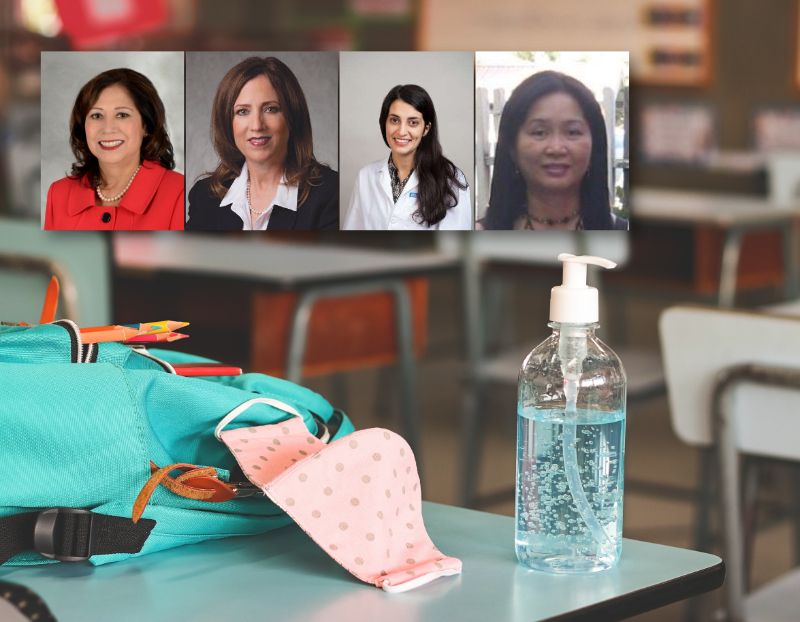Back to School – Is it Safe?
(L-r) Supervisor Hilda L. Solis, Chair of LA County Board of Supervisors, 1st District Supervisor; Superintendent Dr. Debra Duardo, LA County Office of Education; Dr. Nava Yeganeh, Pediatric Infectious Disease Specialist and Medical Epidemiologist, LA County Department of Public Health; Dr. Jasmine Eugenio, Pediatric Senior Physician, LA County Department of Health Services (Photos: Ethnic Media Services)
TL; DR
Although many parents and students are ready to get a taste of freedom again, public health experts caution that in-person learning will come with caveats since the threat of COVID-19 spread still looms. Schools have been extra cautious and have implemented extra safety measures making them one of the safest settings to be in, according to LA County public health experts. Here is a path LA County has outlined to navigate through the constantly evolving battle against COVID-19.
Good News! Students are finally heading back to school. Parents and students feel a sense of relief and there is newfound enthusiasm towards in-person learning since our eyes and brains have been ‘fried’ by virtual learning. However, this in-person learning experience will be different from the one we are accustomed to. Experts in the LA county speak of a multi-dimensional approach implemented to curb the spread of the virus and keeping the children safe. Experts include:
- Supervisor Hilda L. Solis, Chair of LA County Board of Supervisors, 1st District Supervisor
- Superintendent Debra Duardo, LA County Office of Education
- Nava Yeganeh, Pediatric Infectious Disease Specialist and Medical Epidemiologist, LA County Department of Public Health
- Jasmine Eugenio, Pediatric Senior Physician, LA County Department of Health Services
Do students need in-person learning?
Unanimously, all experts across the panel agree that students should go back to in-person learning. Solis points out that it is “instrumental” for their “social and academic well-being, as well as their mental health.” This message was echoed by Dr. Duardo and was agreed upon by others in the panel.
Dr. Duardo also points out that many students and their families are enthusiastic about in-person learning. “We only have about 5-6% of families that asked for independent studies…” These were parents who were impacted by the pandemic and aren’t comfortable sending their kids to schools just yet.
Steps being taken by LA County to curb the spread
Dr. Duardo assures that LA county educators and school staff have adhered to strong safety measures since the pandemic has started. 80% of educators have been vaccinated, according to Dr. Duardo. Everyone is following proper masking guidelines, social distancing, and extra sanitation measures to prevent the spread.
She says that the spread of COVID has been low in schools and believes that schools are one of the “safest places” when looking at this pandemic.
Educators and school officials, along with public health experts, are working hard to make sure schools are the last place for a COVID outbreak.
How do we continue to keep schools safe?
All experts pointed out a multi-layered approach to keeping schools safe for in-person learning. All experts highlighted the importance of getting vaccinated, masking indoors, and following social distancing.
Dr. Nava Yeganeh gave an elaborate breakdown of the current situation in LA county.
She says that LA county is currently facing high transmission of COVID-19 and emphasizes the importance of vaccines, masks, and contact tracing.
As of August 4th, only 50% of LA county residents age 12-17, have received at least one shot. Dr. Yeganeh says that it makes sense since students were the last group of people to get approved for the vaccine. She says that it could be several months before FDA approves the vaccine for kids younger than 12. Till then, LA county has published a framework that Dr. Yeganeh presented:
- Vaccinate if eligible
- Masks required for all indoors
- Improved ventilation
- Stay home when sick and get tested
- Isolation for individuals infected with SARS-CoV2
- Quarantine guidance:
- 10 days after last exposure to infectious individual
- 7 days if tested after day 5
- Symptom monitoring x 14 days
Dr. Eugenio explains that parents have to educate students and mentally prepare them for the new in-person learning experience. She says that parents should accept that some students may feel uncomfortable and anxious when returning to school. Dr. Eugenio gives us a preview of what to expect in classrooms:
- It will be different
- Masks should be worn indoors (ages 2 and older)
- Schools maintain at least 3 feet of physical distance between students within classrooms
- Especially important to layer multiple other prevention strategies
The Big Picture
As families prepare for in-person learning, experts underline the importance of cooperation between students, parents, and teachers to navigate the pandemic. The good news is that many studies confirm that schools are one of the safest places to be in during the outbreak. Dr. Yeganeh highlights that overcoming this pandemic would rely on a “collaborative effort this fall.” Families would have to stay vigilant – getting everyone eligible vaccinated, following masking guidelines, and proactively check for symptoms and isolate when in doubt.
The Gen-Z Take
Some of us have lost our senior years of high school. We faced virtual graduations and missed out on years of the “college experience.” We are tired of being confined to our desks at home and behind a screen. We urge every family to consider public safety and get vaccinated. We urge you to wear masks and socially distance because this pandemic isn’t over, and we don’t want to go through another year of virtual learning. Stop being arrogant and give us our life back!


